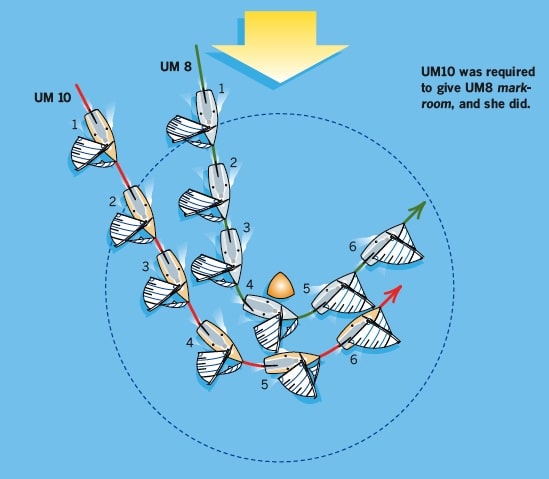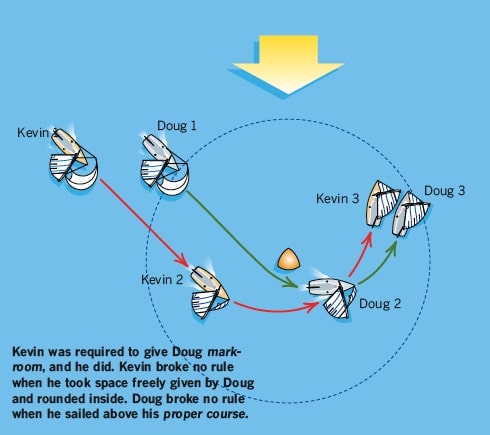The definition of mark-room is, “Room for a boat to sail to the mark, and then room to sail her proper course while at the mark.” It raises two questions: What is “room to sail to the mark?” And when does the transition from sailing “to the mark” to being “at the mark” occur?

New U.S. Appeal 105 answers the above questions. It involved two JY15 dinghies at the leeward mark in a race at the University of Michigan Sailing Club (see the diagram above). When UM8 reached the zone, she was windward boat and overlapped inside UM10. Under Rule 18.2(b), UM8 was, from Position 1 to Position 3, entitled to the space she needed in the existing conditions to sail promptly in a seamanlike way to the mark (definitions Room and Mark- Room). Given that she was on a broad reach and headed toward the mark at Position 1, the space to which she was entitled was a straight corridor from Position 1 to a position close to and on the required side of the mark. Afer she had sailed “to the mark” and was “at” it, she then became entitled to “room to sail her proper course while at the mark.”
In its decision, the U.S. Appeals Committee stated, “The transition between the two types of room occurs at the moment the [inside] boat arrives ‘at’ the mark. In this case UM8 is ‘at’ the mark in Position 3 in the diagram because the mark is abeam of her bow and she is close to the mark.”
The protest committee had decided that UM10 did give UM8 the room she was entitled to, both while she was sailing to the mark and while she was at the mark. The appeals committee agreed. The other applicable rule was Rule 11, which required UM8 to keep clear of UM10. The protest committee and the appeals committee decided that neither boat broke a rule.
New ISAF Case 114 addresses a question that arises when three or more boats are subject to Rule 18.2 at the same time. Suppose that in the incident previously discussed there had been a third boat, UM12, overlapped outside both UM10 and UM8. This raises another question: Does Rule 18.2 require UM12 to give UM10 enough space to enable UM10 to give mark-room to UM8? The answer given by ISAF is worth quoting in full: “Yes. UM10 must give mark-room to UM8, and UM12 must give mark-room to UM10. The definition Mark-Room uses the defined term ‘room’, and room includes space to maneuver in a seamanlike way. The space UM10 needs to maneuver in a seamanlike way includes the space she needs to comply with her obligations to UM8. Therefore, Rule 18.2 requires UM12 to give UM10 sufficient space for UM10 to give UM8 mark-room.”
Case 114 includes another example in which a similar question can arise when three boats are sailing in open water well away from all marks. Suppose that Boats L, M, and W are overlapped and on the same tack with L to leeward, W to windward and M between them, and that Rule 17 does not apply to L. L luffs in a way that requires both M and W to luff to avoid contact. When L changes course, Rule 16.1 requires her, as right-of-way boat under Rule 11, to give M room to keep clear. ISAF states: “The space M needs to maneuver in a seamanlike way includes the space she needs to comply with her obligations to W. Therefore, Rule 16.1 requires L to give M sufficient space for M to give W room to keep clear.”
Case 114 establishes a principle: When a boat is entitled to room, the space she is entitled to includes space for her to keep clear of or give room to other boats when she is required to do so by the rules. It goes on to broaden that principle. In almost every race, Rule 31 applies and requires a boat racing not to touch a mark, and in those situations Case 114 states, “It is not seamanlike to touch a mark.” Therefore, the case’s principle is extended so that, when a boat is entitled to room, the space she is entitled to includes space for her to avoid touching a mark.

Kevin Gregory, from the Buffalo Canoe Club, wrote in with a question about a boat entitled to room to sail her proper course while at a leeward mark. As shown in the second diagram, Kevin, sailing a Beneteau First 44.7, was overlapped outside Doug, sailing a J/120, when Doug reached the zone at the leeward mark at Position 1. Kevin slowed his boat slightly and fell clear astern of Doug while Doug was making a sloppy spinnaker douse and a wide rounding. There was more than enough space for Kevin to slip in between Doug and the mark between Positions 2 and 3. Just after both boats had left the mark astern, but before they left the zone, Doug hailed, “Up, up!” to Kevin and luffed sharply above close-hauled. Kevin was able to keep clear as Doug luffed, but had to go head to wind to avoid contact. As Doug luffed above close-hauled, Kevin hailed, “Sail your proper course!”, but Doug continued luffing. Kevin wrote to ask me whether Doug broke Rule 18.2(b) or any other rule by sailing above his proper course.
Here’s how I would apply the rules in this incident. At Position 1, Rule 18.2(b) began to apply. It required Kevin to “thereafter give [Doug] mark-room.” Also, at Position 1, Rule 11 required Doug, as windward boat, to keep clear of Kevin. When Kevin slowed and became clear astern, Rule 11 ceased to apply and Rule 12 began to require Kevin to keep clear of Doug. Later, between Positions 2 and 3—when Kevin became overlapped to windward of Doug—Rule 11 began to apply again, but this time it required Kevin to keep clear of Doug. Note also that Rule 17 did not apply to Doug after Kevin became overlapped to windward of him, because Doug was clear ahead of Kevin when that overlap began.
It’s obvious from the diagram that Kevin gave Doug “room to sail to the mark.” After Doug’s bow was abeam of and close to the mark, Kevin was required to give Doug room to sail his proper course while at the mark. Doug’s proper course was the course he would have sailed to finish as soon as possible in the absence of Kevin. Since the next leg was a beat to windward, Doug’s proper course would have been to round the mark and assume a close-hauled course. It is clear from the diagram that Kevin gave Doug room to sail his proper course. Therefore, I conclude that Kevin did not break Rule 18.2(b). Kevin had other obligations during the incident. While he was clear astern of Doug and later after he became overlapped to windward of Doug, Kevin was required, first by Rule 12 and after the overlap began by Rule 11, to keep clear. As the diagram shows, Kevin complied with both of those rules. Kevin was perfectly within his rights to sail between Doug and the mark provided he broke no rule while doing so. ISAF Case 63 is very clear on this point. Kevin broke no rule in the incident.
But did Doug break a rule?
No. During the short time after Position 1 that Doug was the windward boat, he kept clear of Kevin. Thereafter, Doug had right of way. When he luffed above close-hauled (which was also above his proper course), Rule 17 did not apply but Rule 16.1 did. Doug complied with Rule 16.1 because he gave Kevin room to keep clear. Kevin argued that, because Doug sailed above his proper course while still in the zone (and therefore while Rule 18 still applied), Doug broke Rule 18.2(b). That’s not correct. Rule 18.2(b) entitled Doug to room to sail his proper course, but it did not require him to sail only that course. Rule 18 no longer “switches off” or “takes precedence” over other rules. When Doug luffed above his close-hauled proper course at Position 3, he had every right to do so and Kevin was required to keep clear. If Kevin had protested Doug I would have found that neither boat broke a rule.









